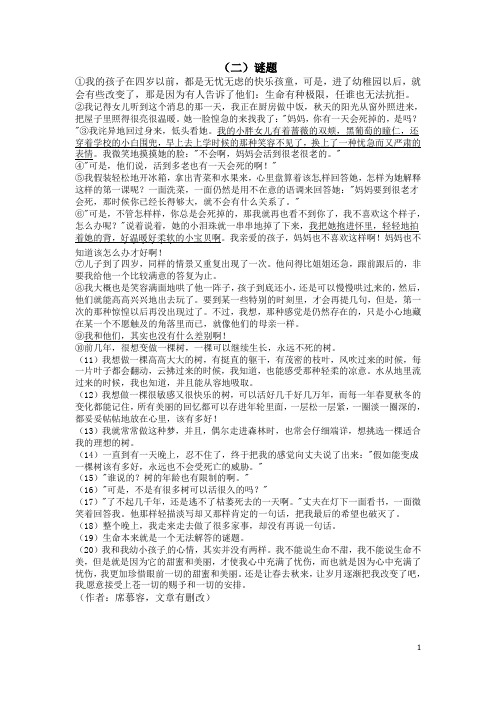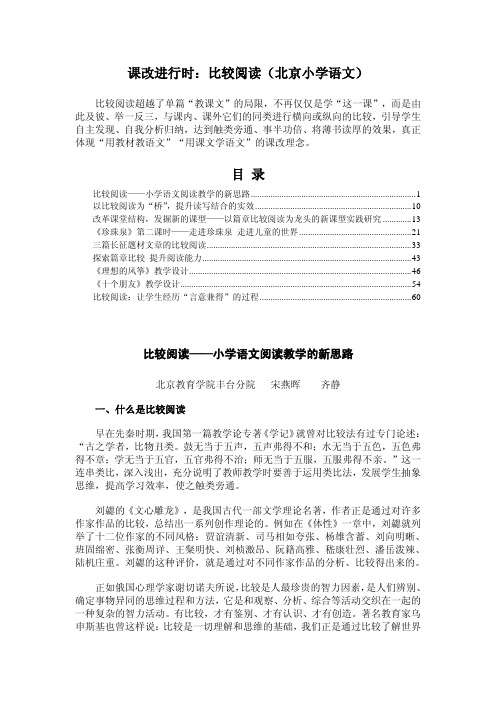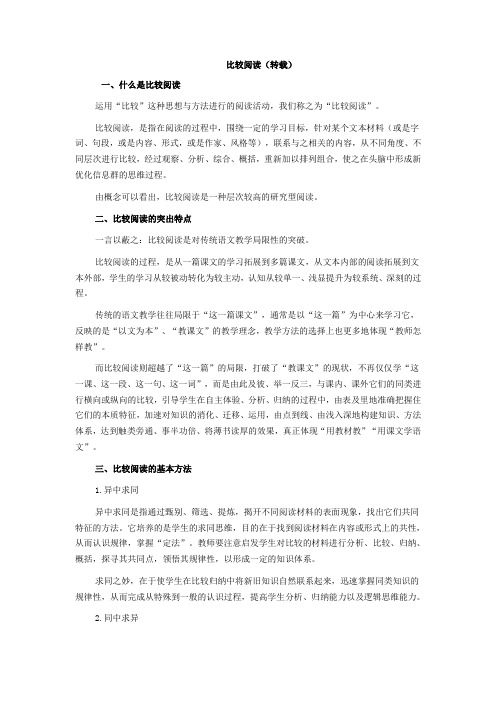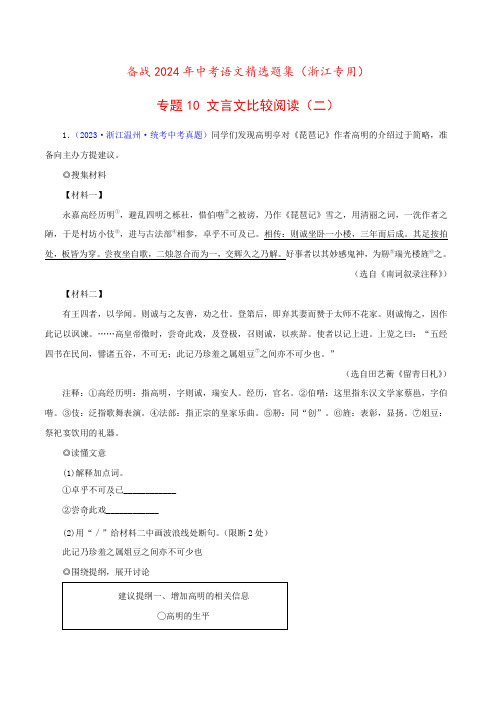11比较阅读
- 格式:ppt
- 大小:562.00 KB
- 文档页数:11

小学语文阅读中的比较阅读探讨一、比较阅读的定义比较阅读是指通过对比两个或多个事物的共同点和不同点,来加深对所阅读内容的理解和思考的一种阅读方式。
比较阅读可以是对同一篇文章内的事物进行对比,也可以是对不同文章、不同过程或不同概念进行对比。
比较阅读的内容可以是不同作者的作品,不同年代的文学作品,也可以是不同地区、不同民族的传统文化等。
比较阅读的内容可以丰富多样,帮助学生拓宽视野,提高文化素养。
1. 对比共性对比共性是比较阅读的基本方法之一。
通过对比事物的共同点,可以深入理解事物的本质和特征。
学生可以通过对比不同动物的共性,了解到动物的基本特征和分类。
2. 对比差异对比差异是比较阅读的另一种方法。
通过对比事物的不同点,可以发现事物之间的差异,拓宽学生的思维广度。
学生可以通过对比不同国家的文化传统,了解到不同民族的生活方式和价值观念的差异。
3. 对比评价对比评价是比较阅读的一种高级方法。
通过对比不同作者或不同作品的优缺点,可以培养学生的批判性思维和创新能力。
学生可以通过对比不同作家的文学风格和表达方式,进一步理解文学的艺术魅力和表达技巧。
1. 帮助学生理解课文比较阅读可以帮助学生更深入地理解课文内容。
通过对比课文中的事物或人物,可以加深学生对课文的理解,提高阅读理解能力。
2. 拓展学生的思维广度比较阅读可以拓展学生的思维广度,增强学生的批判性思维和创新能力。
通过对比不同作品或不同观点,可以培养学生的独立思考和创造性思维。
3. 提高学生的文化素养比较阅读可以帮助学生了解不同文化传统和不同地区的特点,提高学生的文化素养和跨文化交际能力。
五、总结比较阅读是一种重要的阅读方式,它通过对比事物的共性和差异,帮助学生深入理解和思考所阅读的内容。
在小学语文教学中,比较阅读不仅可以提高学生的阅读能力,还可以培养学生的思维品质和文化素养。
在日常教学中,教师可以通过设计丰富多样的比较阅读活动,提升学生的阅读兴趣和阅读能力。

(二)谜题①我的孩子在四岁以前,都是无忧无虑的快乐孩童,可是,进了幼稚园以后,就会有些改变了,那是因为有人告诉了他们:生命有种极限,任谁也无法抗拒。
②我记得女儿听到这个消息的那一天,我正在厨房做中饭,秋天的阳光从窗外照进来,把屋子里照得很亮很温暖。
她一脸惶急的来找我了:"妈妈,你有一天会死掉的,是吗?"③我诧异地回过身来,低头看她。
我的小胖女儿有着蔷薇的双颊,黑葡萄的瞳仁,还穿着学校的小白围兜,早上去上学时候的那种笑容不见了,换上了一种忧急而又严肃的表情。
我微笑地摸摸她的脸:"不会啊,妈妈会活到很老很老的。
"④"可是,他们说,活到多老也有一天会死的啊!"⑤我假装轻松地开冰箱,拿出青菜和水果来,心里盘算着该怎样回答她,怎样为她解释这样的第一课呢?一面洗菜,一面仍然是用不在意的语调来回答她:"妈妈要到很老才会死,那时候你已经长得够大,就不会有什么关系了。
"⑥"可是,不管怎样样,你总是会死掉的,那我就再也看不到你了,我不喜欢这个样子,怎么办呢?"说着说着,她的小泪珠就一串串地掉了下来,我把她抱进怀里,轻轻地拍着她的背,好温暖好柔软......的小宝贝啊。
我亲爱的孩子,妈妈也不喜欢这样啊!妈妈也不知道该怎么办才好啊!⑦儿子到了四岁,同样的情景又重复出现了一次。
他问得比姐姐还急,跟前跟后的,非要我给他一个比较满意的答复为止。
⑧我大概也是笑容满面地哄了他一阵子,孩子到底还小,还是可以慢慢哄过来的,然后,他们就能高高兴兴地出去玩了。
要到某一些特别的时刻里,才会再提几句,但是,第一次的那种惊惶以后再没出现过了。
不过,我想,那种感觉是仍然存在的,只是小心地藏在某一个不愿触及的角落里而已,就像他们的母亲一样。
⑨我和他们,其实也没有什么差别啊!⑩前几年,很想变做一棵树,一棵可以继续生长,永远不死的树。
(11)我想做一棵高高大大的树,有挺直的躯干,有茂密的枝叶,风吹过来的时候,每一片叶子都会翻动,云拂过来的时候,我知道,也能感受那种轻柔的凉意。

第11课《醉翁亭记》比较阅读训练班级姓名成绩(一)阅读下面两篇文言文,完成13-17题。
(16分)【甲】环滁皆山也。
其西南诸峰,林壑尤美,望之蔚然而深秀者,琅琊也。
山行六七里,渐闻水声潺潺,而泻出于两峰之间者,酿泉也。
峰回路转,有亭翼然临于泉上者,醉翁亭也。
作亭者谁?山之僧智仙也。
名之者谁?太守自谓也。
太守与客来饮于此,饮少辄醉,而年又最高,故自号日醉翁也。
醉翁之意不在酒,在乎山水之间也。
山水之乐,得之心而寓之酒也。
(选自欧阳修《醉翁亭记》)【乙】寓山之胜不能以寓山收盖缘身在山中也。
子瞻于匡庐道之矣。
此亭不暱①于山,故能尽有山。
几叠楼台,嵌入苍崖翠壁,时有云气往来缥缈,掖②层霄而上。
仰面贪看,恍然置身天际,若并不知有亭也。
倏然回目,乃在一水中。
激石穿林,泠泠传响,非但可以乐饥,且涤十年尘土肠胃。
夫置屿于池,置亭于屿,如大海一沤③然。
而众妙都④焉,安得不动高人之欣赏乎!(选自祁彪佳《寓山注·妙赏亭》)【注释】①暱:同“呢”,亲近。
这里指挨近,靠拢。
②掖:搀扶。
挟持。
③沤:水中气泡。
④都:汇聚。
13.根据文意,用“/”给下面句子断句。
(限断两处)(2分)寓山之胜不能以寓山收盖缘身在山中也。
14.阅读【甲】【乙】两文,按要求答题。
(3分)(1)解释【甲】文中加点字的意思。
峰回路转,有亭翼然临.于泉上者,醉翁亭也。
临:________________(2)请从【乙】文中找出直接写妙赏亭建造位置的句子。
________________________________________________________________________________ 15.用现代汉语写出下面句子的意思。
(5分)(1)山行六七里,渐闻水声潺潺,而泻出于两峰之间者,酿泉也。
________________________________________________________________________________ (2)此亭不暱于山,故能尽有山。

课改进行时:比较阅读(北京小学语文)比较阅读超越了单篇“教课文”的局限,不再仅仅是学“这一课”,而是由此及彼、举一反三,与课内、课外它们的同类进行横向或纵向的比较,引导学生自主发现、自我分析归纳,达到触类旁通、事半功倍、将薄书读厚的效果,真正体现“用教材教语文”“用课文学语文”的课改理念。
目录比较阅读——小学语文阅读教学的新思路 (1)以比较阅读为“桥”,提升读写结合的实效 (10)改革课堂结构,发掘新的课型——以篇章比较阅读为龙头的新课型实践研究 (13)《珍珠泉》第二课时——走进珍珠泉走进儿童的世界 (21)三篇长征题材文章的比较阅读 (33)探索篇章比较提升阅读能力 (43)《理想的风筝》教学设计 (46)《十个朋友》教学设计 (54)比较阅读:让学生经历“言意兼得”的过程 (60)比较阅读——小学语文阅读教学的新思路北京教育学院丰台分院宋燕晖齐静一、什么是比较阅读早在先秦时期,我国第一篇教学论专著《学记》就曾对比较法有过专门论述:“古之学者,比物丑类。
鼓无当于五声,五声弗得不和;水无当于五色,五色弗得不章;学无当于五官,五官弗得不治;师无当于五服,五服弗得不亲。
”这一连串类比,深入浅出,充分说明了教师教学时要善于运用类比法,发展学生抽象思维,提高学习效率,使之触类旁通。
刘勰的《文心雕龙》,是我国古代一部文学理论名著,作者正是通过对许多作家作品的比较,总结出一系列创作理论的。
例如在《体性》一章中,刘勰就列举了十二位作家的不同风格:贾谊清新、司马相如夸张、杨雄含蓄、刘向明晰、班固绵密、张衡周详、王粲明快、刘桢激昂、阮籍高雅、嵇康壮烈、潘岳泼辣、陆机庄重。
刘勰的这种评价,就是通过对不同作家作品的分析、比较得出来的。
正如俄国心理学家谢切诺夫所说,比较是人最珍贵的智力因素,是人们辨别、确定事物异同的思维过程和方法,它是和观察、分析、综合等活动交织在一起的一种复杂的智力活动。
有比较,才有鉴别、才有认识、才有创造。

比较阅读(转载)一、什么是比较阅读运用“比较”这种思想与方法进行的阅读活动,我们称之为“比较阅读”。
比较阅读,是指在阅读的过程中,围绕一定的学习目标,针对某个文本材料(或是字词、句段,或是内容、形式,或是作家、风格等),联系与之相关的内容,从不同角度、不同层次进行比较,经过观察、分析、综合、概括,重新加以排列组合,使之在头脑中形成新优化信息群的思维过程。
由概念可以看出,比较阅读是一种层次较高的研究型阅读。
二、比较阅读的突出特点一言以蔽之:比较阅读是对传统语文教学局限性的突破。
比较阅读的过程,是从一篇课文的学习拓展到多篇课文,从文本内部的阅读拓展到文本外部,学生的学习从较被动转化为较主动,认知从较单一、浅显提升为较系统、深刻的过程。
传统的语文教学往往局限于“这一篇课文”,通常是以“这一篇”为中心来学习它,反映的是“以文为本”、“教课文”的教学理念,教学方法的选择上也更多地体现“教师怎样教”。
而比较阅读则超越了“这一篇”的局限,打破了“教课文”的现状,不再仅仅学“这一课、这一段、这一句、这一词”,而是由此及彼、举一反三,与课内、课外它们的同类进行横向或纵向的比较,引导学生在自主体验、分析、归纳的过程中,由表及里地准确把握住它们的本质特征,加速对知识的消化、迁移、运用,由点到线、由浅入深地构建知识、方法体系,达到触类旁通、事半功倍、将薄书读厚的效果,真正体现“用教材教”“用课文学语文”。
三、比较阅读的基本方法1.异中求同异中求同是指通过甄别、筛选、提炼,揭开不同阅读材料的表面现象,找出它们共同特征的方法。
它培养的是学生的求同思维,目的在于找到阅读材料在内容或形式上的共性,从而认识规律,掌握“定法”。
教师要注意启发学生对比较的材料进行分析、比较、归纳、概括,探寻其共同点,领悟其规律性,以形成一定的知识体系。
求同之妙,在于使学生在比较归纳中将新旧知识自然联系起来,迅速掌握同类知识的规律性,从而完成从特殊到一般的认识过程,提高学生分析、归纳能力以及逻辑思维能力。

备战2024年中考语文精选题集(浙江专用)专题10 文言文比较阅读(二)1.(2023·浙江温州·统考中考真题)同学们发现高明亭对《琵琶记》作者高明的介绍过于简略,准备向主办方提建议。
◎搜集材料【材料一】永嘉高经历明①,避乱四明之栎社,惜伯喈②之被谤,乃作《琵琶记》雪之,用清丽之词,一洗作者之陋,于是村坊小伎③,进与古法部④相参,卓乎不可及已。
相传:则诚坐卧一小楼,三年而后成。
其足按拍处,板皆为穿。
尝夜坐自歌,二烛忽合而为一,交辉久之乃解。
好事者以其妙感鬼神,为剙⑤瑞光楼旌⑥之。
(选自《南词叙录注释》)【材料二】有王四者,以学闻。
则诚与之友善,劝之仕。
登第后,即弃其妻而赞于太师不花家。
则诚悔之,因作此记以讽谏。
……高皇帝微时,尝奇此戏,及登极,召则诚,以疾辞。
使者以记上进。
上览之曰:“五经四书在民间,譬诸五谷,不可无;此记乃珍羞之属俎豆⑦之间亦不可少也。
”(选自田艺蘅《留青日札》)注释:①高经历明:指高明,字则诚,瑞安人。
经历,官名。
②伯喈:这里指东汉文学家蔡邕,字伯喈。
③伎:泛指歌舞表演。
④法部:指正宗的皇家乐曲。
⑤剙:同“创”。
⑥旌:表彰,显扬。
⑦俎豆:祭祀宴饮用的礼器。
◎读懂文意(1)解释加点词。
①卓乎不可及.已____________②尝奇.此戏____________(2)用“/”给材料二中画波浪线处断句。
(限断2处)此记乃珍羞之属俎豆之间亦不可少也◎围绕提纲,展开讨论(3)同学质疑:材料一中画横线处作为“高明的故事”素材是否合适?发表你的看法并阐述理由。
(4)同学提议:增加《琵琶记》创作缘由。
根据两则材料,概括《琵琶记》创作缘由的两种说法。
(5)同学讨论:还可以增加《琵琶记》的哪些信息?结合两则材料,提一条建议并阐述理由。
撰写建议(略)(2023·浙江嘉兴·统考中考真题)程本立,字原道,嘉兴崇德人。
少读书,不务章句。
闻金华朱彦修兄弟得考亭之学①于白云许谦,乃往就学焉。
人教版语文九下《送东阳马生序》比较阅读7篇班级________姓名_________一、阅读下面【甲】【乙】两篇文言文,完成14-17题。
(15分)【甲】余幼时即嗜学。
家贫,无从致书以观,每假借于藏书之家,手自笔录,计日以还。
天大寒,砚冰坚,手指不可屈伸,弗之怠。
录毕,走送之,不敢稍逾约。
以是人多以书假余,余因得遍观群书。
既加冠,益慕圣贤之道。
又患无硕师名人与游,尝趋百里外,从乡之先达执经叩问。
先达德隆望尊,门人弟子填其室,未尝稍降辞色。
余立侍左右,援疑质理,俯身倾耳以请;或遇其叱咄,色愈恭,礼愈至,不敢出一言以复;俟其欣悦,则又请焉。
故余虽愚,卒获有所闻。
(选自《送东阳马生序》)【乙】许衡①字仲平,怀之河内人也,……稍长,嗜学如饥渴,然遭世乱,且贫无书。
尝从日者②家见疏义③,因请寓宿,手抄归。
既逃难徂徕山,始得《易》王辅嗣说。
时兵乱中,衡夜思昼诵,身体而力践之,言动必揆诸义而后发。
尝暑中过河阳,渴甚,道有梨,众争取啖之,衡独危坐树下自若。
或问之,曰:“非其有而取之,不可也。
”人日:“世乱,此无主。
”日:“梨无主,吾心独无主乎?”(选自《元史·列传第四十五》)【注释】①许衡:元初大臣。
②日者:古时称占h的人。
⑧疏义:指为古书旧注所作的阐释。
14.解释下列加点词在文中的意思。
(4分)(1)弟子填.其室填:____________ (2)援.疑质理援:____________(3)俟.其欣悦俟:____________ (4)危.坐树下危:____________15.翻译下列句子。
(4分)(1)从乡之先达执经叩问。
译文:_________________________________________________________________________ (2)衡夜思昼诵,身体而力践之。
译文:_________________________________________________________________________ 16.【甲】【乙】两篇选文在内容上有什么相同之处? (4分)答:___________________________________________________________________________ _______________________________________________________________________________ 17.【甲】【乙】两篇选文在内容上有什么不同之处?(3分)答:___________________________________________________________________________ _______________________________________________________________________________ 二、阅读下面【甲】【乙】两篇文言文,完成10-14题。
2017届中考语文二轮专题复习11 文言文比较阅读练习编辑整理:尊敬的读者朋友们:这里是精品文档编辑中心,本文档内容是由我和我的同事精心编辑整理后发布的,发布之前我们对文中内容进行仔细校对,但是难免会有疏漏的地方,但是任然希望(2017届中考语文二轮专题复习11 文言文比较阅读练习)的内容能够给您的工作和学习带来便利。
同时也真诚的希望收到您的建议和反馈,这将是我们进步的源泉,前进的动力。
本文可编辑可修改,如果觉得对您有帮助请收藏以便随时查阅,最后祝您生活愉快业绩进步,以下为2017届中考语文二轮专题复习11 文言文比较阅读练习的全部内容。
11.文言文比较阅读【基础练习】1。
以下几句话编为四组,分别体现宋濂诚信、明礼的是( )①录毕,走送至,不敢稍逾越②手指不可屈伸,弗之怠③或遇其叱咄,色愈恭,礼愈至,不敢出一言以复④余立侍左右,援疑质理,俯身倾耳以请(A)①④ (B)②③(C)①③(D)③④【课内练习】[甲]舜发于畎亩之中,傅说举于版筑之间,胶鬲举于鱼盐之中,管夷吾举于士,孙叔敖举于海,百里奚举于市,故天将降大任于是人也,必先苦其心志,劳其筋骨,饿其体肤,空乏其身,行拂乱其所为,所以动心忍性,曾益其所不能。
人恒过然后能改,困于心衡于虑而后作,征于色发于声而后喻。
入则无法家拂士,出则无敌国外患者,国恒亡,然后知生于忧患而死于安乐也。
(选自《孟子·告子下》) [乙]世言晋王①之将终也,以三矢赐庄宗而告之曰:“吾有三遗恨,与尔三矢,尔其无忘乃父之志!"庄宗受而藏之于庙。
其后用兵,则遣从事②以一少牢③告庙,请其矢,盛以锦囊,负而前驱,及凯旋而纳之。
方其还矢先王,而告以成功,其意气之盛,可谓壮矣!及仇雠④已灭,天下已定,则专宠伶官,沉溺声色,朝政皆废。
终至一夫夜呼,乱者四应,仓皇东出,不知所归,何其衰也!忧劳可以兴国,逸豫可以亡身,自然之理也。
(选自《新五代史·伶官传》,有删改)注:①晋王:即李克用,因帮助唐朝镇压黄巢起义有功封为晋王。
剑桥雅思阅读11真题及答案解析(test3)雅思阅读部分一直都是中国考生比较重视的题目,并且也是很有难度的题目,针对于雅思阅读真题资料也是大家需要重点分析的。
今天小编就给大家带来了关于剑桥雅思阅读11原文参考译文以及答案(test3)的内容,一起来分析一下吧。
剑桥雅思阅读11原文(test3)READING PASSAGE 1You should spend about 20 minutes on Questions 1-13, which are based on Reading Passage 1 below.THE STORY OF SILKThe history of the world’s most luxurious fabric, from ancient China to the present daySilk is a fine, smooth material produced from the cocoons —soft protective shells —that are made by mulberry silkworms (insect larvae). Legend has it that it was Lei Tzu, wife of the Yellow Emperor, ruler of China in about 3000 BC, who discovered silkworms. One account of the story goes that as she was taking a walk in her husband’s gardens, she discovered that silkworms were responsible for the destruction of several mulberry trees. She collected a number of cocoons and sat down to have a rest. It just so happened that while she was sipping some tea, one of the cocoons that she had collected landed in the hot tea and started to unravel into a fine thread. Lei Tzu found that she could wind this thread around her fingers. Subsequently, she persuaded her husband to allow her to rear silkworms on a grove of mulberry trees. She also devised a special reel to draw the fibres from the cocoon into a single thread so that they would be strong enough to be woven into fabric. While it is unknown just how much of this is true, it is certainly known that silk cultivationhas existed in China for several millennia.Originally, silkworm farming was solely restricted to women, and it was they who were responsible for the growing, harvesting and weaving. Silk quickly grew into a symbol of status, and originally, only royalty were entitled to have clothes made of silk. The rules were gradually relaxed over the years until finally during the Qing Dynasty (1644-1911 AD), even peasants, the lowest caste, were also entitled to wear silk. Sometime during the Han Dynasty (206 BC-220 AD), silk was so prized that it was also used as a unit of currency. Government officials were paid their salary in silk, and farmers paid their taxes in grain and silk. Silk was also used as diplomatic gifts by the emperor. Fishing lines, bowstrings, musical instruments and paper were all made using silk. The earliest indication of silk paper being used was discovered in the tomb of a noble who is estimated to have died around 168 AD.Demand for this exotic fabric eventually created the lucrative trade route now known as the Silk Road, taking silk westward and bringing gold, silver and wool to the East. It was named the Silk Road after its most precious commodity, which was considered to be worth more than gold. The Silk Road stretched over 6,000 kilometres from Eastern China to the Mediterranean Sea, following the Great Wall of China, climbing the Pamir mountain range, crossing modern-day Afghanistan and going on to the Middle East, with a major trading market in Damascus. From there, the merchandise was shipped across the Mediterranean Sea. Few merchants travelled the entire route; goods were handled mostly by a series of middlemen.With the mulberry silkworm being native to China, the country was the world’s sole producer of silk for many hundreds of years. The secret of silk-making eventually reached the rest ofthe world via the Byzantine Empire, which ruled over the Mediterranean region of southern Europe, North Africa and the Middle East during the period 330-1453 AD. According to another legend, monks working for the Byzantine emperor Justinian smuggled silkworm eggs to Constantinople (Istanbul in modern-day Turkey) in 550 AD, concealed inside hollow bamboo walking canes. The Byzantines were as secretive as the Chinese, however, and for many centuries the weaving and trading of silk fabric was a strict imperial monopoly. Then in the seventh century, the Arabs conquered Persia, capturing their magnificent silks in the process. Silk production thus spread through Africa, Sicily and Spain as the Arabs swept through these lands. Andalusia in southern Spain was Europe’s main silk-producing centre in the tenth century. By the thirteenth century, however, Italy had become Europe’s leader in silk production and export. Venetian merchants traded extensively in silk and encouraged silk growers to settle in Italy. Even now, silk processed in the province of Como in northern Italy enjoys an esteemed reputation.The nineteenth century and industrialisation saw the downfall of the European silk industry. Cheaper Japanese silk, trade in which was greatly facilitated by the opening of the Suez Canal, was one of the many factors driving the trend. Then in the twentieth century, new manmade fibres, such as nylon, started to be used in what had traditionally been silk products, such as stockings and parachutes. The two world wars, which interrupted the supply of raw material from Japan, also stifled the European silk industry. After the Second World War, Japan’s silk production was restored, with improved production and quality of raw silk. Japan was to remain the world’s biggest producer of raw silk, and practically the only major exporter of raw silk, untilthe 1970s. However, in more recent decades, China has gradually recaptured its position as the world’s biggest producer and exporter of raw silk and silk yarn. Today, around 125,000 metric tons of silk are produced in the world, and almost two thirds of that production takes place in China.Questions 1-9Complete the notes below.Choose ONE WORD ONLY from the passage for each answer.Write your answers in boxes 1-9 on your answer sheet.THE STORY OF SILKEarly silk production in ChinaAround 3000 BC, according to legend:- silkworm cocoon fell into emperor’s wife’s 1 __________- emperor’s wife invented a 2 __________ to pull out silk fibresOnly 3 __________ were allowed to produce silkOnly 4 __________ were allowed to wear silkSilk used as a form of 5 __________- e.g. farmers’ taxes consisted partly of silkSilk used for many purposes- e.g. evidence found of 6 __________ made from silk around 168 ADSilk reaches rest of worldMerchants use Silk Road to take silk westward and bring back 7 __________ and precious metals550 AD: 8 __________ hide silkworm eggs in canes and take them to ConstantinopleSilk production spreads across Middle East and Europe20th century: 9 __________ and other manmade fibres cause decline in silk productionQuestions 10-13Do the following statements agree with the information in Reading Passage 1?In boxes 10-13 on your answer sheet, writeTRUE if the statement agrees with the informationFALSE if the statement contradicts the informationNOT GIVEN if there is no information on this10 Gold was the most valuable material transported along the Silk Road.11 Most tradesmen only went along certain sections of the Silk Road.12 The Byzantines spread the practice of silk production across the West.13 Silk yarn makes up the majority of silk currently exported from China.READING PASSAGE 2You should spend about 20 minutes on Questions 14-26, which are based on Reading Passage 2 below.Great MigrationsAnimal migration, however it is defined, is far more than just the movement of animals. It can loosely be described as travel that takes place at regular intervals ?— often in an annual cycle — that may involve many members of a species, and is rewarded only after a long journey. It suggests inherited instinct. The biologist Hugh Dingle has identified five characteristics that apply, in varying degrees and combinations, to all migrations. They are prolonged movements that carry animals outside familiar habitats; they tend to be linear, not zigzaggy; they involve special behaviours concerning preparation (such as overfeeding) and arrival; they demand special allocations of energy. And onemore: migrating animals maintain an intense attentiveness to the greater mission, which keeps them undistracted by temptations and undeterred by challenges that would turn other animals aside.An arctic tern, on its 20,000 km flight from the extreme south of South America to the Arctic circle, will take no notice of a nice smelly herring offered from a bird-watcher’s boat along the way. While local gulls will dive voraciously for such handouts, the tern flies on. Why? The arctic tern resists distraction because it is driven at that moment by an instinctive sense of something we humans find admirable: larger purpose. In other words, it is determined to reach its destination. The bird senses that it can eat, rest and mate later. Right now it is totally focused on the journey; its undivided intent is arrival.Reaching some gravelly coastline in the Arctic, upon which other arctic terns have converged, will serve its larger purpose as shaped by evolution: finding a place, a time, and a set of circumstances in which it can successfully hatch and rear offspring.But migration is a complex issue, and biologists define it differently, depending in part on what sorts of animals they study. Joe! Berger, of the University of Montana, who works on the American pronghorn and other large terrestrial mammals, prefers what he calls a simple, practical definition suited to his beasts: ‘movements from a seasonal home area away to another home area and back again’. Generally the reason for such seasonal back-and-forth movement is to seek resources that aren’t available within a single area year-round.But daily vertical movements by zooplankton in the ocean —upward by night to seek food, downward by day to escapepredators —can also be considered migration. So can the movement of aphids when, having depleted the young leaves on one food plant, their offspring then fly onward to a different host plant, with no one aphid ever returning to where it started.Dingle is an evolutionary biologist who studies insects. His definition is more intricate than Berger’s, citing those five features that distinguish migration from other forms of movement. They allow for the fact that, for example, aphids will become sensitive to blue light (from the sky) when it’s time for takeoff on their big journey, and sensitive to yellow light (reflected from tender young leaves) when it’s appropriate to land. Birds will fatten themselves with heavy feeding in advance of a long migrational flight. The value of his definition, Dingle argues, is that it focuses attention on what the phenomenon of wildebeest migration shares with the phenomenon of the aphids, and therefore helps guide researchers towards understanding how evolution has produced them all.Human behaviour, however, is having a detrimental impact on animal migration. The pronghorn, which resembles an antelope, though they are unrelated, is the fastest land mammal of the New World. One population, which spends the summer in the mountainous Grand Teton National Park of the western USA, follows a narrow route from its summer range in the mountains, across a river, and down onto the plains. Here they wait out the frozen months, feeding mainly on sagebrush blown clear of snow. These pronghorn are notable for the invariance of their migration route and the severity of its constriction at three bottlenecks. If they can’t pass through each of the three during their spring migration, they can’t reach their bounty of summer grazing; if they can’t pass through again in autumn, escaping south ontothose windblown plains, they are likely to die trying to overwinter in the deep snow. Pronghorn, dependent on distance vision and speed to keep safe from predators, traverse high, open shoulders of land, where they can see and run. At one of the bottlenecks, forested hills rise to form a V, leaving a corridor of open ground only about 150 metres wide, filled with private homes. Increasing development is leading toward a crisis for the pronghorn, threatening to choke off their passageway.Conservation scientists, along with some biologists and land managers within the USA’s National Park Service and other agencies, are now working to preserve migrational behaviours, not just species and habitats. A National Forest has recognised the path of the pronghorn, much of which passes across its land, as a protected migration corridor. But neither the Forest Service nor the Park Service can control what happens on private land at a bottleneck. And with certain other migrating species, the challenge is complicated further —by vastly greater distances traversed, more jurisdictions, more borders, more dangers along the way. We will require wisdom and resoluteness to ensure that migrating species can continue their journeying a while longer.Questions 14-18Do the following statements agree with the information given in Reading Passage 2?In boxes 14-18 on your answer sheet, writeTRUE if the statement agrees with the informationFALSE if the statement contradicts the informationNOT GIVEN if there is no information on this14 Local gulls and migrating arctic terns behave in the same way when offered food.15 Experts’ definitions of migration tend to vary accordingto their area of study.16 Very few experts agree that the movement of aphids can be considered migration.17 Aphids’ journeys are affected b y changes in the light that they perceive.18 Dingle’s aim is to distinguish between the migratory behaviours of different species.Questions 19-22Complete each sentence with the correct ending, A-G, below.Write the correct letter, A-G, in boxes 19-22 on your answer sheet.19 According to Dingle, migratory routes are likely to20 To prepare for migration, animals are likely to21 During migration, animals are unlikely to22 Arctic terns illustrate migrating animals’ ability toA be discouraged by difficulties.B travel on open land where they can look out for predators.C eat more than they need for immediate purposes.D be repeated daily.E ignore distractions.F be governed by the availability of water.G follow a straight line.Questions 23-26Complete the summary below.Choose ONE WORD ONLY from the passage for each answer.Write your answers in boxes 23-26 on your answer sheet.The migration of pronghornsPronghorns rely on their eyesight and 23 __________ to avoid predators. One particular pop ulation’s summer habitat is a national park, and their winter home is on the 24 __________,where they go to avoid the danger presented by the snow at that time of year. However, their route between these two areas contains three 25 __________. One problem is the construction of new homes in a narrow 26 __________ of land on the pronghorns’ route.READING PASSAGE 3You should spend about 20 minutes on Questions 27-40, which are based on Reading Passage 3 below.Preface to ‘How the other half thinks: Adventu res in mathematical reasoning’A Occasionally, in some difficult musical compositions, there are beautiful, but easy parts — parts so simple a beginner could play them. So it is with mathematics as well. There are some discoveries in advanced mathematics that do not depend on specialized knowledge, not even on algebra, geometry, or trigonometry. Instead they may involve, at most, a little arithmetic, such as ‘the sum of two odd numbers is even’, and common sense. Each of the eight chapters in this book illustrates this phenomenon. Anyone can understand every step in the reasoning.The thinking in each chapter uses at most only elementary arithmetic, and sometimes not even that. Thus all readers will have the chance to participate in a mathematical experience, to appreciate the beauty of mathematics, and to become familiar with its logical, yet intuitive, style of thinking.B One of my purposes in writing this book is to give readers who haven’t had the opportunity to see and enjoy real mathematics the chance to appreciate the mathematical way of thinking. I want to reveal not only some of the fascinating discoveries, but, more importantly, the reasoning behind them.In that respect, this book differs from most books on mathematics written for the general public. Some present the lives of colorful mathematicians. Others describe important applications of mathematics. Yet others go into mathematical procedures, but assume that the reader is adept in using algebra.C I hope this book will help bridge that notorious gap that separates the two cultures: the humanities and the sciences, or should I say the right brain (intuitive) and the left brain (analytical, numerical). As the chapters will illustrate, mathematics is not restricted to the analytical and numerical; intuition plays a significant role. The alleged gap can be narrowed or completely overcome by anyone, in part because each of us is far from using the full capacity of either side of the brain. To illustrate our human potential, I cite a structural engineer who is an artist, an electrical engineer who is an opera singer, an opera singer who published mathematical research, and a mathematician who publishes short stories.D Other scientists have written books to explain their fields to non-scientists, but have necessarily had to omit the mathematics, although it provides the foundation of their theories. The reader must remain a tantalized spectator rather than an involved participant, since the appropriate language for describing the details in much of science is mathematics, whether the subject is expanding universe, subatomic particles, or chromosomes. Though the broad outline of a scientific theory can be sketched intuitively, when a part of the physical universe is finally understood, its description often looks like a page in a mathematics text.E Still, the non-mathematical reader can go far in understanding mathematical reasoning. This book presents thedetails that illustrate the mathematical style of thinking, which involves sustained, step-by-step analysis, experiments, and insights. You will turn these pages much more slowly than when reading a novel or a newspaper. It may help to have a pencil and paper ready to check claims and carry out experiments.F As I wrote, I kept in mind two types of readers: those who enjoyed mathematics until they were turned off by an unpleasant episode, usually around fifth grade, and mathematics aficionados, who will find much that is new throughout the book.This book also serves readers who simply want to sharpen their analytical skills. Many careers, such as law and medicine, require extended, precise analysis. Each chapter offers practice in following a sustained and closely argued line of thought. That mathematics can develop this skill is shown by these two testimonials:G A physician wrote, ‘The discipline of analytical thought processes [in mathematics] prepared me extremely well for medical school. In medicine one is faced with a problem which must be thoroughly analyzed before a solution can be found. The proces s is similar to doing mathematics.’A lawyer made the same point, ‘Although I had no background in law — not even one political science course — I did well at one of the best law schools. I attribute much of my success there to having learned, through the study of mathematics, and, in particular, theorems, how to analyze complicated principles. Lawyers who have studied mathematics can master the legal principles in a way that most others cannot.’I hope you will share my delight in watching as simple, even na?ve, questions lead to remarkable solutions and purely theoretical discoveries find unanticipated applications.Questions 27-34Reading Passage 3 has seven sections, A-G.Which section contains the following information?Write the correct letter, A-G, in boxes 27-34 on your answer sheet.NB You may use any letter more than once.27 a reference to books that assume a lack of mathematical knowledge28 the way in which this is not a typical book about mathematics29 personal examples of being helped by mathematics30 examples of people who each had abilities that seemed incompatible31 mention of different focuses of books about mathematics32 a contrast between reading this book and reading other kinds of publication33 a claim that the whole of the book is accessible to everybody34 a reference to different categories of intended readers of this bookQuestions 35-40Complete the sentences below.Choose ONE WORD ONLY from the passage for each answer.Write your answers in boxes 35-40 on your answer sheet.35 Some areas of both music and mathematics are suitable for someone who is a __________.36 It is sometimes possible to understand advanced mathematics using no more than a limited knowledge of __________.37 The writer intends to show that mathematics requires__________ thinking, as well as analytical skills.38 Some books written by __________ have had to leave out the mathematics that is central to their theories.39 The writer advises non-mathematical readers to perform __________ while reading the book.40 A lawyer found that studying __________ helped even more than other areas of mathematics in the study of law.剑桥雅思阅读11原文参考译文(test3)PASSAGE 1 参考译文:丝绸的故事世上最昂贵奢华织物的历史,从古代中国直到今天丝绸是种细软、光滑的布料,产自桑蚕(该昆虫的幼体形态)制作出的蚕茧——即其柔软的保护性外壳。